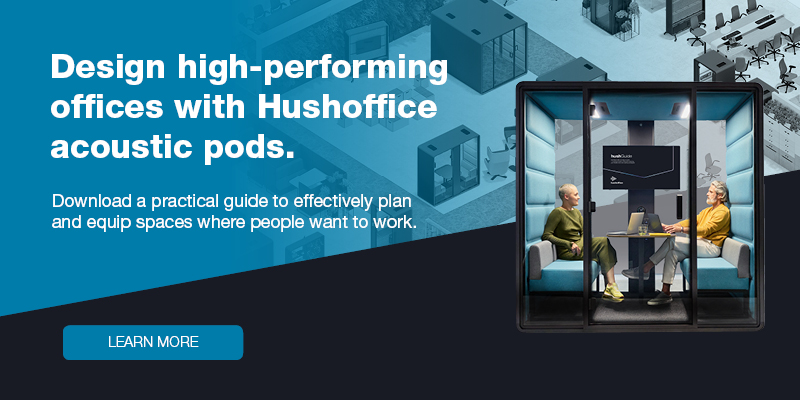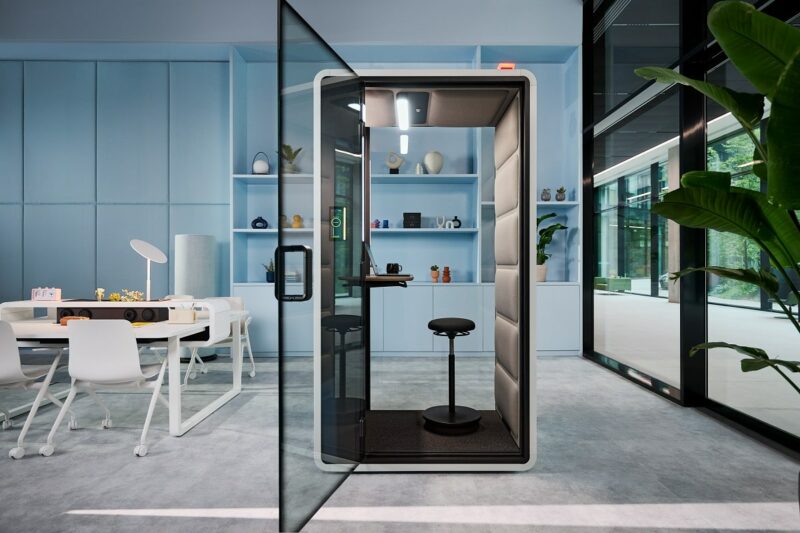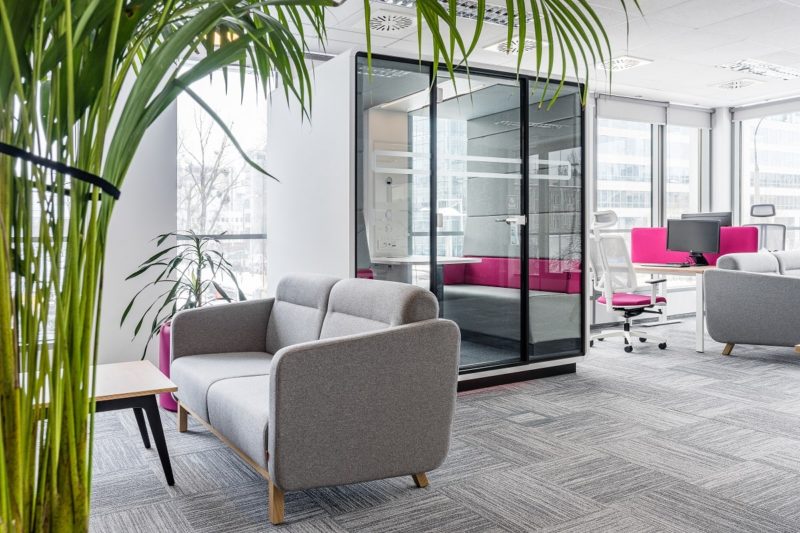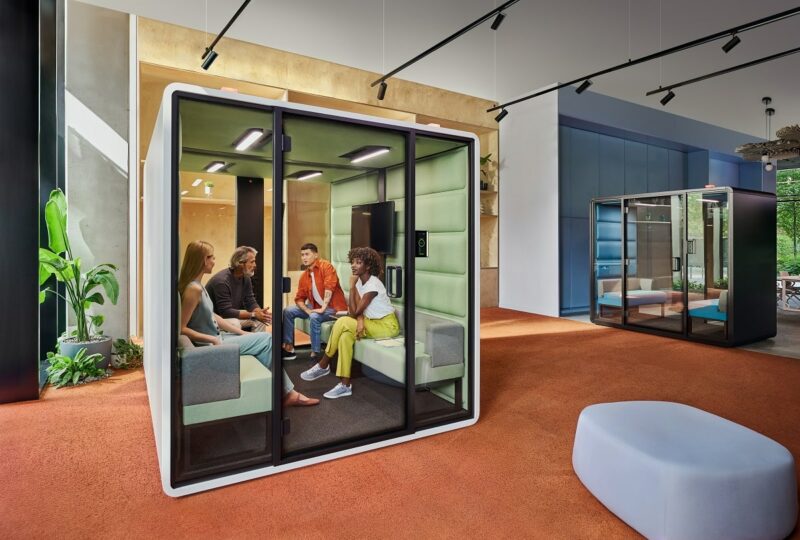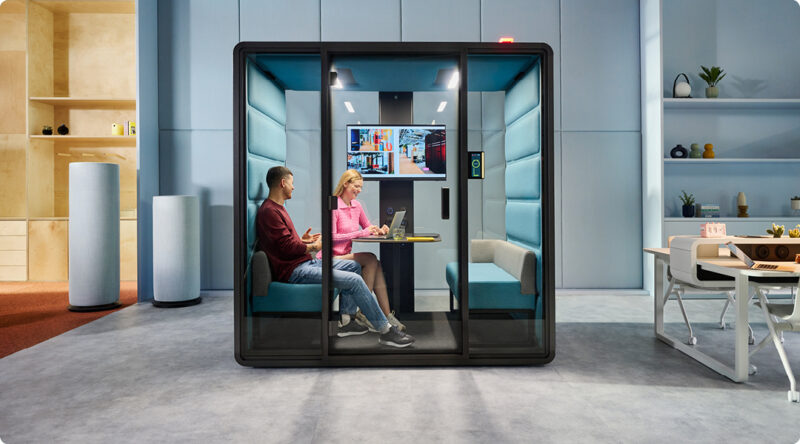Enhance mental well-being through a well-zoned activity-based office space
- Posted on: 1 February 2024
- By: Hushoffice Team
A well-designed activity-based workspace bolsters team morale. It ensures the ideal balance between “open” and “closed” areas. When backed by universal design principles, it has a positive impact on performance. Let’s have a look at the research on this subject.
Enhancing mental well-being in an efficiently zoned activity-based workplace – tl;dr
Access to a wide variety of zones is the essence of an inclusive, activity-based workspace. While changing work locations can indeed have a positive impact on performance and creativity, there is one paramount condition: privacy. In fact, it’s privacy that matters the most when employees choose a workspace in an activity-based office. Naturally, privacy is directly connected with well-being.
Personal control is another essential liberty that an ABW office should offer to meet the needs of both neurotypical and neurodivergent employees. In fact, personal control is one of the most important building blocks of job satisfaction. While most people find lack of control stressful, the feeling of being empowered helps lower stress levels, positively influencing mental well-being.
Thermal comfort and impeccable acoustics have a beneficial impact on workers regardless of their individual cognitive structure. Thus, to ensure the most optimum mental state of all employees, an activity-based workplace needs to offer control over noise levels and temperature. Hushoffice pods and booths hit the mark, offering flexibility and adjustability over the basic aspects of the working environment, such as ventilation, lighting, noise, and privacy.
What influence does the physical work environment have on employee health?
Businesses should carefully consider their office design as a well-thought-out workspace contributes to a calmer, more productive atmosphere. Eventually, employees who feel relaxed and comfortable in their office will perform at their best.
Stress, exhaustion, and a fast-paced work environment are parts of professional everyday life for many employees.
Sadly, 83% of US employees suffer from work-related stress, with one quarter considering their job number one life stressor. Moreover, over two-thirds of workers experience fatigue through their workday.
Fatigue impairs cognitive abilities: attention, memory, and impulse control.
This explains why tired employees are 6% less productive. In fact, fatigue at work costs American companies $136 billion annually in health-related lost productivity. One worker experiencing fatigue daily may cost an employer $3,500 a year in absenteeism, medical expenses, and reduced productivity.
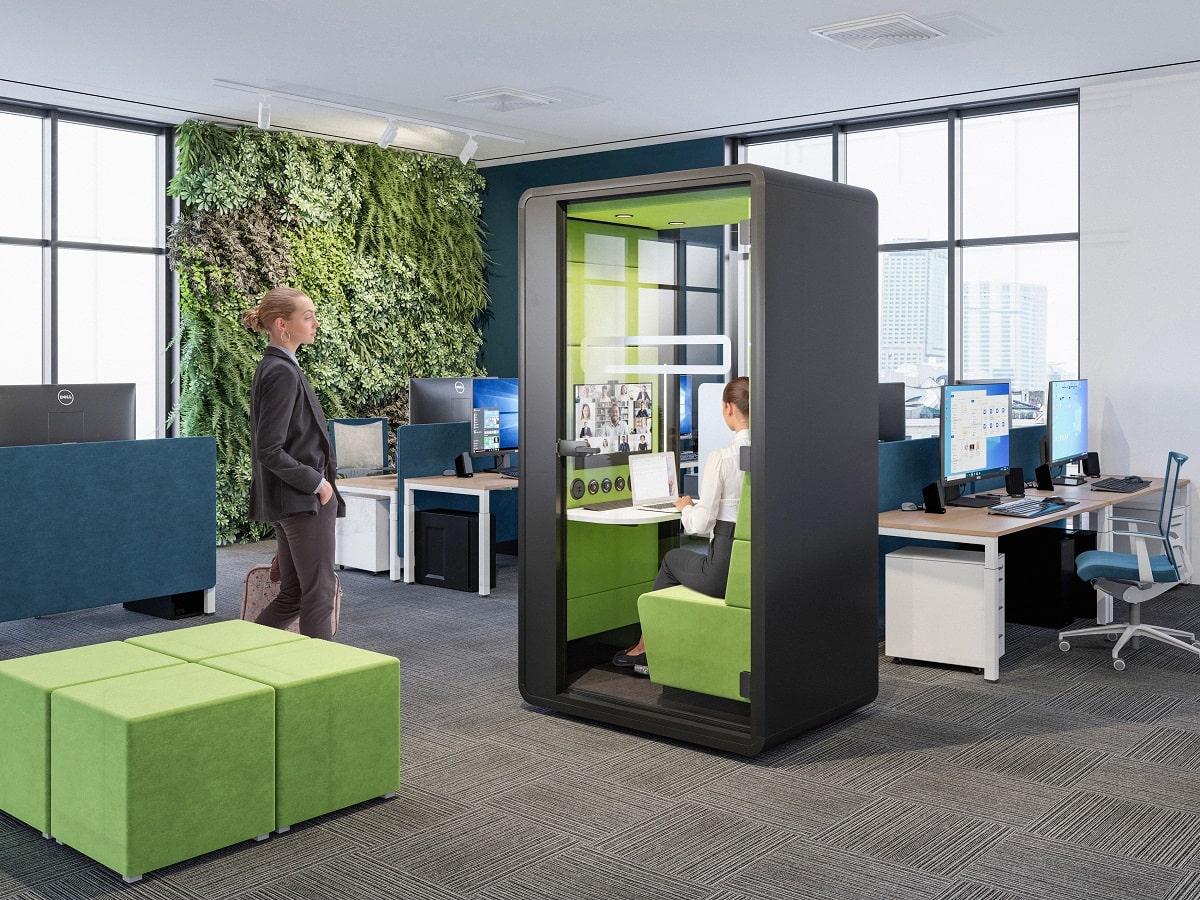
Can the workspace support the mental well-being of employees?
Definitely! Office colours alone have a powerful impact on employee mood. And in terms of stimuli, for example, a private work booth, such as hushWork, offers an instant stress relief for sensory-avoidant employees.
According to research by the World Green Building Council, there is an 11% increase in productivity resulting from enhanced air quality and a decrease in pollutants in the working environment.
A study carried out by the Department of Design and Environmental Analysis at Cornell proved that workers seated within 10 feet of a window report a 84% reduction in eyestrain, headaches, and blurred vision issues.
Research by Public Health England showed that a higher degree of personal control over the working environment and easier access to meeting spaces mean increased job satisfaction and higher perception of team unity.
The working environment is equally significant to the task at hand.
The workspace lays the foundation for smooth performance. A well-designed one fosters efficient and successful collaboration. As presented in this article, excellent lighting, comfortable furniture, and a well-organised setup are crucial.
Different people, different needs – universal design (UD) for everyone.
Also referred to as inclusive design, UD guarantees the accessibility of every environment. An inclusive workspace caters for all needs and neurology. And, as Jean-Baptiste says, “if you do not intentionally, deliberately and proactively include, you will unintentionally exclude.”
The principles of universal design are reliable as they prioritise the focus and wellness of all employees, catering for the whole range of individuals from those with attention issues to the extroverted ones. They suggest a few major improvements. Firstly, structures and spaces should be designed to meet the needs of employees with different abilities while remaining user-friendly and intuitive in communicating necessary information regardless of individuals’ sensory abilities. There should be no room for user error, and the space design must support individuals with different body sizes, postures, and mobility. In a nutshell, the space must work for everyone
– says Mateusz Barczyk, Senior Brand Manager, Hushoffice.
One out of seven people is neurodivergent.
Obviously, to create an effective workspace supporting all employee types (including the neurodivergent), it is crucial to work with employees directly. Only then can individual needs be fully understood, leading to the emergence and introduction of totally new inclusive solutions.
Read more: Office design for neurodiverse workforce
Surely, inclusive design is essential to office innovation.
After all, looking at things from different angles contributes to more effective problem-solving. What’s more, diversity is a desired value on your team if you want to remain relevant in an increasingly diverse world.
What factors should be taken into account while looking for universal office design?
Environmental and spatial factors, above all. For example, some workers are overly sensitive to light, noise or air pollutants. And, universally, sit-stand desks, control over lighting and temperature, recreation rooms for socialising, and quiet zones are all fundamentals of an inclusive workplace.
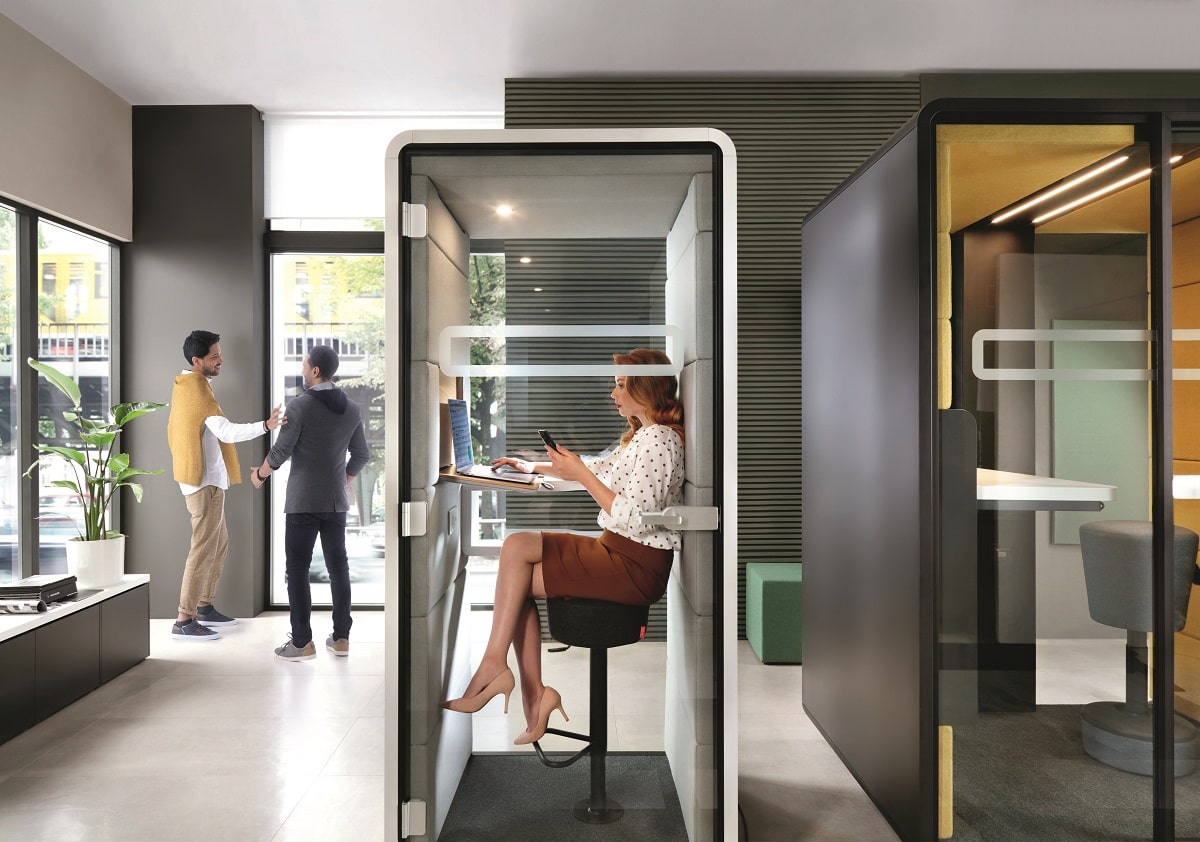
The choice of lighting and furniture may make or break the accessibility of a workplace.
It’s worth noting that furniture ergonomics and lighting have the greatest impact on the well-being of neurodiverse employees. That’s why, the choice between fluorescent-overhead lighting and adjustable lighting or soft, unsupportive swivel chairs versus ergonomic sit-stand seating may be a game-changer.
A recent survey focused on differences between the needs of neurotypical and neurodivergent workers, providing guidance on how to improve accessibility through office design. It showed that room decor and layout exhibit strong positive correlation with creativity, particularly when it comes to neurodiverse employees. On the other hand, thermal comfort and acoustics benefit all, regardless of their cognitive structure. But the big thing contributing to higher levels of job satisfaction for both groups of employees is, in fact, personal control. With this finding in mind, we are pleased to present our Hushoffice booths which grant users control over crucial aspects ensuring comfort: ventilation, privacy, lighting, and acoustics
– says Mateusz Barczyk, Senior Brand Manager, Hushoffice.
Working better in a flexible work environment.
While designing a flexible work environment, a workspace planner will always take into account number-one aspects: privacy and noise levels. But the runner-up is a factor often overlooked, though backed by research: a sense of personal or individual control.
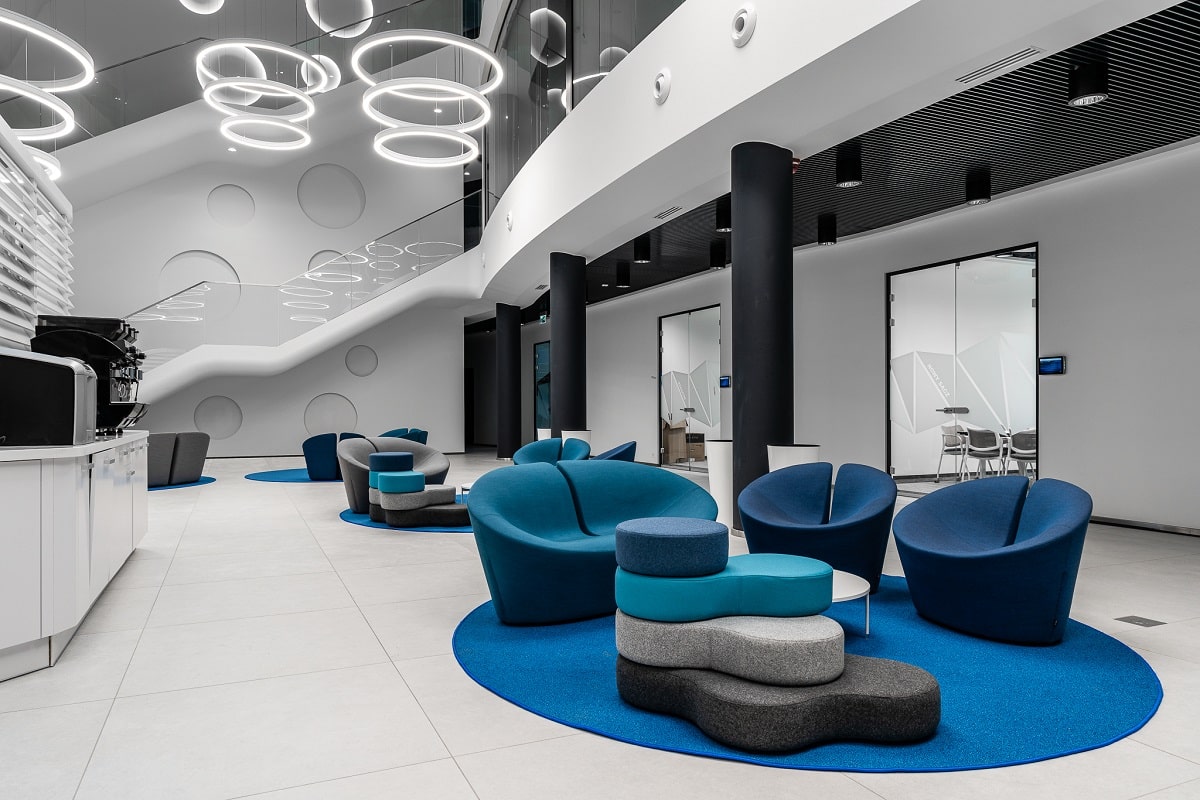
Introducing greenery into the workspace is a boost to calm the senses.
Nature helps reduce stress levels. Even short virtual nature breaks taken in a private space, such as a pod, can work wonders. Spending as little as a quarter listening to nature sounds or watching a waterfall footage can substantially mitigate negative emotions and anxiety while boosting the relaxing parasympathetic activity of the nervous system.
Have you already seen our greenWall? It is a vertical garden that brings nature closer for the benefit of all.
Employee-friendly open-plan office means a workspace divided into zones
Intelligent and innovative zoning (or space division) creates an intelligent and innovative workspace. Those considering implementing ABW principles into their workspace design, should take into account insights from a 2023 case study evaluating three activity-based flexible office layouts:
Zone variation is the essence of an activity-based workspace, reflected in clear design elements, spatial seclusion, and excellent soundproofing. All these ingredients create an accessible environment where employees can easily read, comprehend, and use their office zones in the most efficient way.
“Deficient zoning” is a significant issue characterised by an unequal allocation of various zone types and workstations, along with a lack of optimum balance between open, transparent areas and closed, private ones.
An office that is deficiently-zoned lacks the readability of each zone and overall space intuitiveness, contributing to unnecessary stress and delays that employees must endure while navigating their workplace. Also, workers may struggle to comprehend and use each zone effectively.
Have you seen our hushMeet.open yet? It is a semi-enclosed office booth that offers a blend of openness and seclusion.
There needs to be a balance between concentration and teamwork.
Generally, employees’ criteria for choosing a workstation in an activity-based office concern privacy. Thus, in order to create an effective activity-based workspace, it’s crucial to ensure a balanced proportion of open to private work environments.
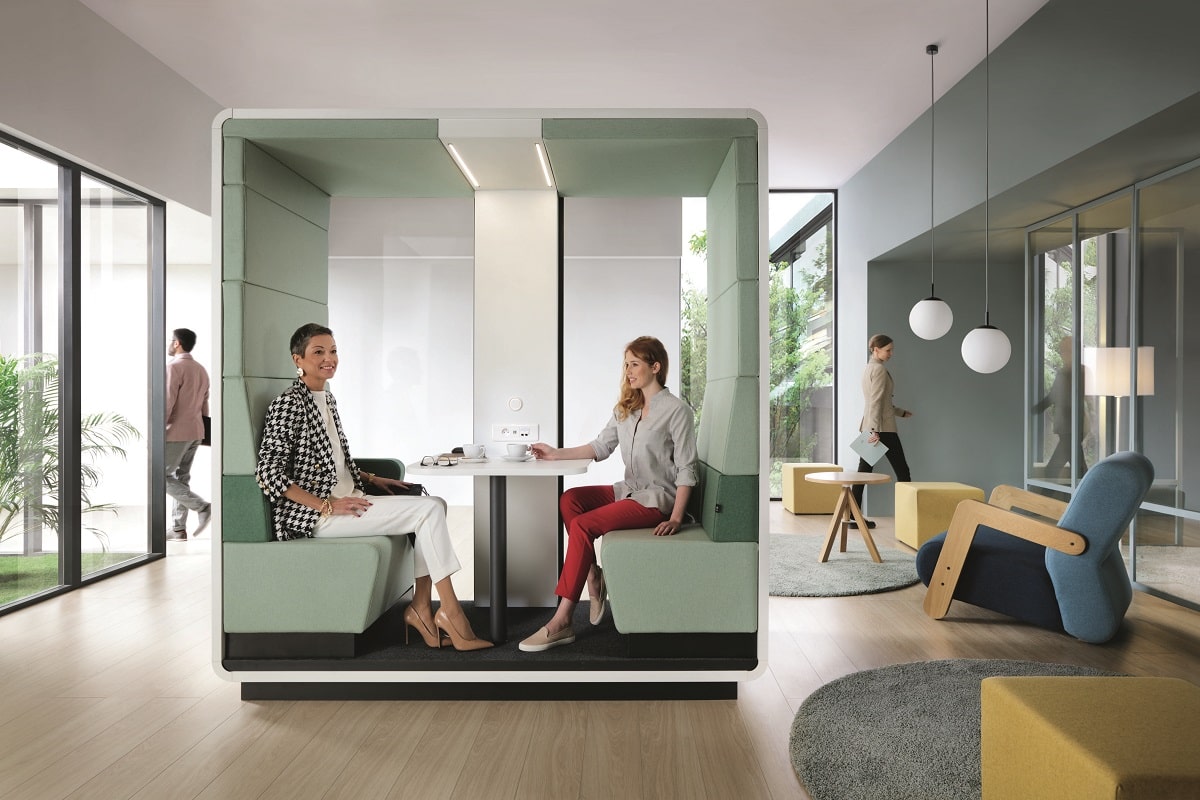
Flexibility and adaptability are essential.
As already mentioned, personal control is one of the most significant factors influencing employee satisfaction and environmental comfort. Interestingly, higher degrees of direct personal control make up more than 80% of an occupant satisfaction level.
A sense of personal control may help reduce workspace distractions!
When employees are granted personal control, allowing them to adjust their office work environments to their needs, the negative consequences of office noise can be minimised. This also supports the argument for office pods that offer control and cancel out distractions.
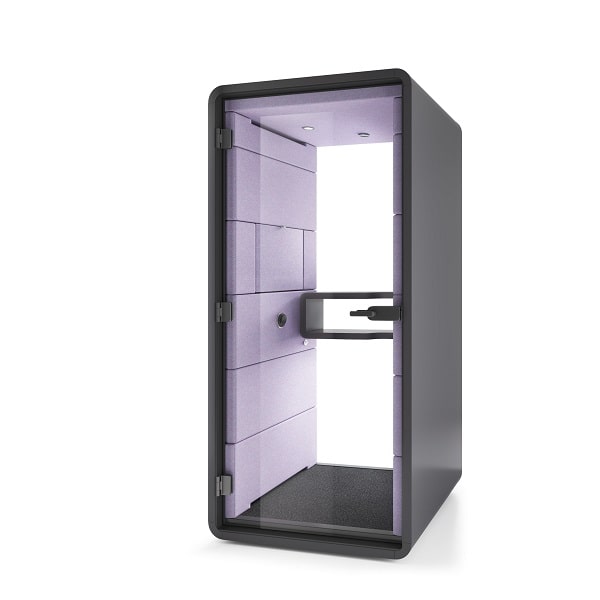
Employees need dedicated spaces for socialisation
Spontaneous chit-chat can be uplifting, energising, and inspiring. Office pods make excellent meeting areas, where team members can hold interesting discussions and enhance their work relations.
Find out more: How “isolation” pods make the office more social, not less
Alternatives to working at a desk positively influence performance and cognitive processes.
Did you know that changing work locations may boost employee performance and creative thinking? Although it’s true indeed, in-depth research on the subject suggests that in an activity-based workspace where employees switch their locations on a regular basis, privacy is the recipe for success.
While communication and collaboration are significant elements of activity-based offices, ensuring necessary privacy is often overlooked. Undoubtedly, solutions such as acoustic baffles, sound-dampening space dividers, desktop privacy screens, and soundproof pods are an excellent finishing touch of a functional activity-based workspace. Implementing such solutions allows employees to enjoy an optimal degree of personal space
– explains Mateusz Barczyk, Senior Brand Manager, Hushoffice.
Acoustic cabins. Top-notch work and relaxation spaces that meet everyone’s needs.
Pods, booths, and cabins improve an activity-based workspace by ensuring general accessibility. They are private, quiet environments where speech is secure. Their professional look follows the aesthetics of a high-quality meeting space. Last, but not least, they are user-adjustable to guarantee maximum comfort.
HushMeet.L acoustic booth. A perfect space to escape from the office hustle and bustle.
Workers are in need of spaces allowing them to meet up without disturbing others. HushMeet.L is spot-on. It’s a large office booth ideal for meetings of all sizes. It is available with modern furniture or empty, allowing customers to furnish it according to their liking.

HushPhone. Privacy within your reach.
Every call deserves confidentiality. HushPhone is a one-person booth perfect for private phone calls. It’s equipped with top-notch upholstered interior panels, excellent sound insulation, and a leaning armrest providing comfort during longer chats.
HushMeet. Space for innovative thinking.
Need seclusion? If yes, hushMeet is a four-person meeting booth perfect for you. It is conveniently furnished and finished. Thanks to its mobility, you can effortlessly relocate it whenever necessary.
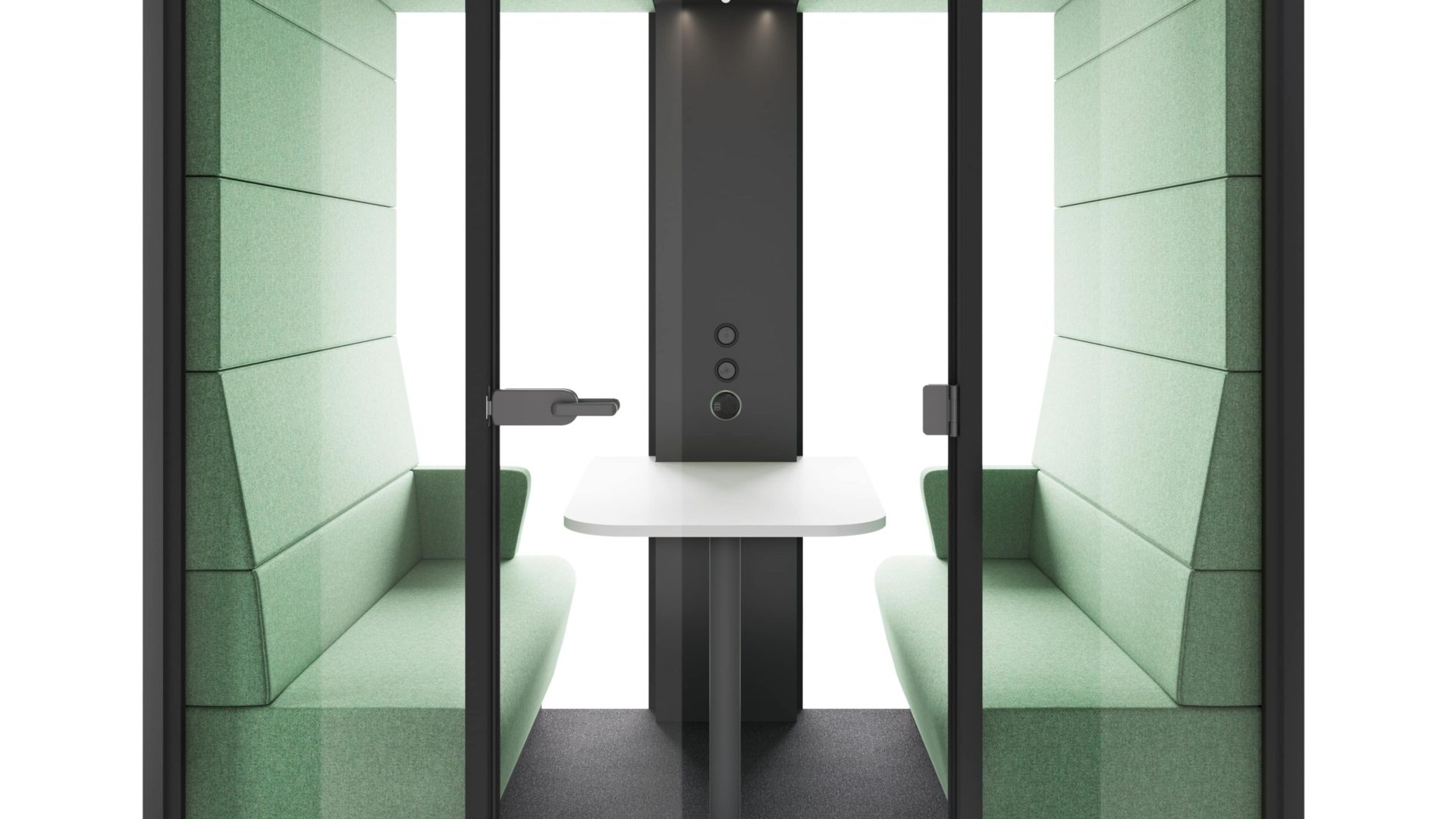
HushHybrid. Effortless communication via video call.
Hybrid meetings have become part of the everyday working world. HushHybrid is a one-person pod perfect for smooth video conferencing. Equipped with extra LED light strips, it illuminates the user’s face, highlighting facial expressions.
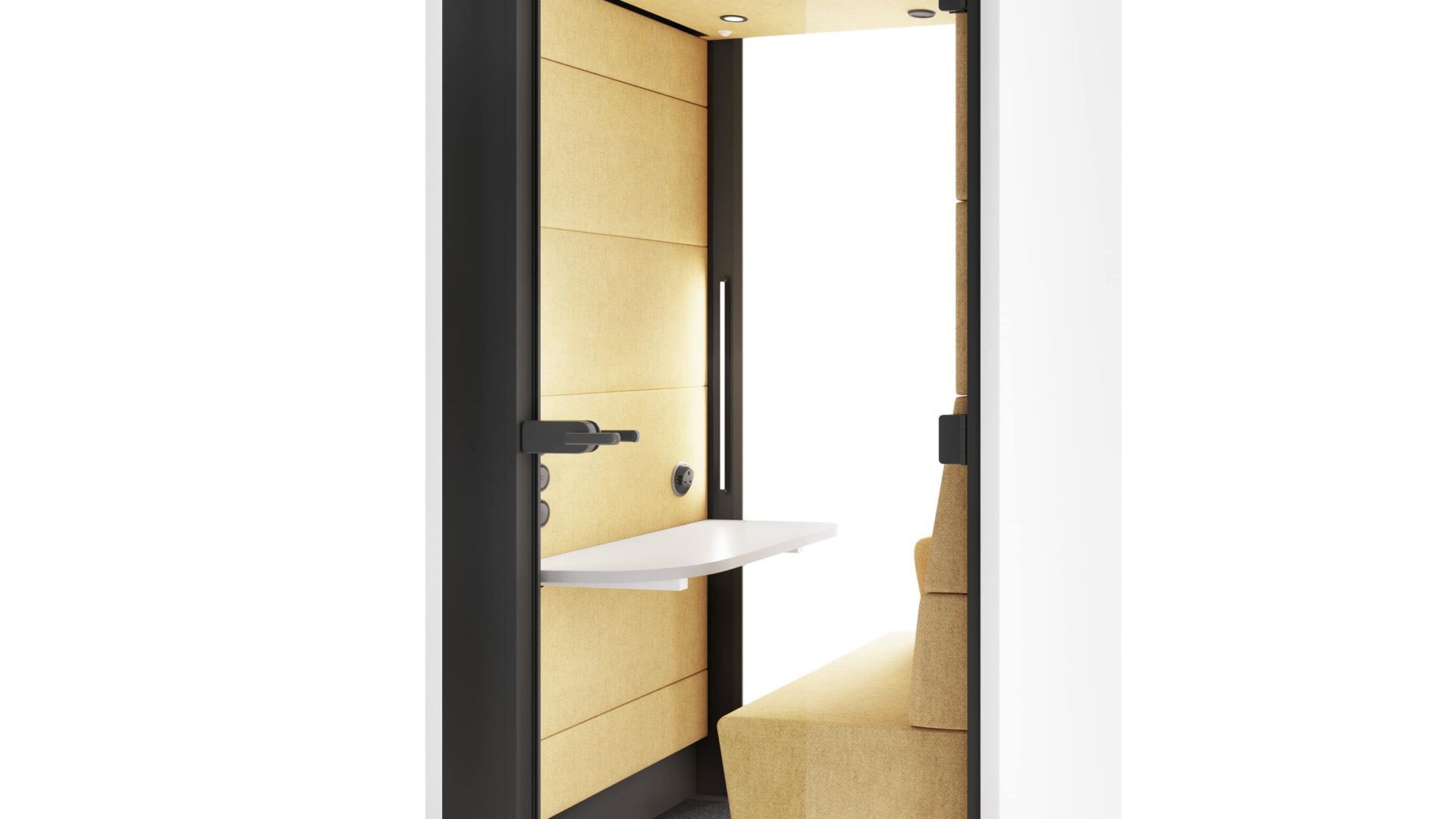
Read more: How to zone the office for hybrid work
Enhancing mental well-being in an efficiently zoned activity-based workplace
Access to a wide variety of zones is the essence of an inclusive, activity-based workspace. While changing work locations can indeed have a positive impact on performance and creativity, there is one paramount condition: privacy. In fact, it’s privacy that matters the most when employees choose a workspace in an activity-based office. Naturally, privacy is directly connected with well-being.
Personal control is another essential liberty that an ABW office should offer to meet the needs of both neurotypical and neurodivergent employees. In fact, personal control is one of the most important building blocks of job satisfaction. While most people find lack of control stressful, the feeling of being empowered helps lower stress levels, positively influencing mental well-being.
Thermal comfort and impeccable acoustics have a beneficial impact on workers regardless of their individual cognitive structure. Thus, to ensure the most optimum mental state of all employees, an activity-based workplace needs to offer control over noise levels and temperature. Hushoffice pods and booths hit the mark, offering flexibility and adjustability over the basic aspects of the working environment, such as ventilation, lighting, noise, and privacy.
Supporting mental well-being with an activity-based office space – frequently asked questions
What kind of office design supports mental well-being?
The best booster for mental well-being is an activity-based office, where design follows and accommodates everyone’s individual needs. Such a type of office offers both flexibility and inclusiveness, allowing employees to choose their optimal work setting. Adjustable desks, a number of seating options, and private, hushed areas make it a versatile, comfortable solution.
How can office work pods contribute to employee mental well-being?
Pods and cabins offer an exceptional combination of privacy, control, and flexibility, bolstering mental well-being in a few effective ways. By blocking out sound, they address the primary cause of sensory overload in the open-plan office – noise. They cocoon their users in a quiet, private space, offering a sense of autonomy over the working environment, which positively impacts their morale. Last, but not least, pods and cabins allow team members to collaborate effectively without the fear of being overheard or judged by their colleagues on the floor.
What makes an office space attractive to employees?
Interestingly, one of the most significant factors influencing occupant satisfaction is a sense of personal control. A high degree of direct personal control accounts for more than 80% of employee satisfaction. Self-contained, adjustable spaces, such as office booths, are worth the investment as they grant workers control over lighting, ventilation, and acoustics.

